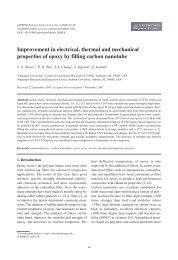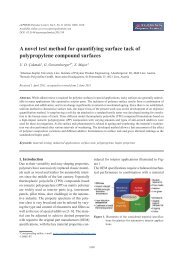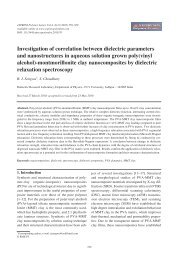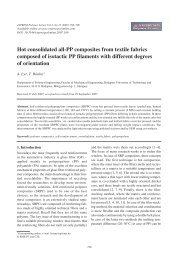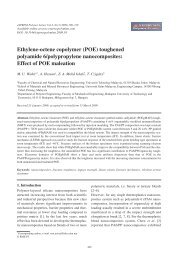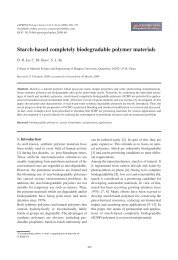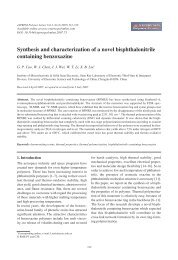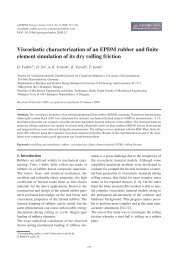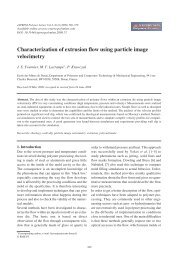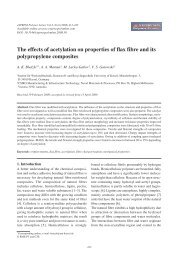Nanotechnology and its applications in lignocellulosic composites, a ...
Nanotechnology and its applications in lignocellulosic composites, a ...
Nanotechnology and its applications in lignocellulosic composites, a ...
Create successful ePaper yourself
Turn your PDF publications into a flip-book with our unique Google optimized e-Paper software.
Kamel – eXPRESS Polymer Letters Vol.1, No.9 (2007) 546–575<br />
weight ratio while allow<strong>in</strong>g for flexibility to<br />
counter large dimensional changes due to swell<strong>in</strong>g<br />
<strong>and</strong> shr<strong>in</strong>k<strong>in</strong>g. These unique properties of wood are<br />
a direct result of <strong>its</strong> hierarchical <strong>in</strong>ternal structure.<br />
Microfibrils, nano-order-unit (10 nm×3.5 nm) [15]<br />
fibers that compose most fiber cell walls, consist of<br />
monocrystall<strong>in</strong>e cellulose doma<strong>in</strong>s with cellulose<br />
cha<strong>in</strong>s parallel to the microfibril axis. As they are<br />
devoid of cha<strong>in</strong> fold<strong>in</strong>gs <strong>and</strong> conta<strong>in</strong> only a small<br />
number of defects, each microfibril can be considered<br />
a str<strong>in</strong>g of polymer whiskers hav<strong>in</strong>g a modulus<br />
close to that of the perfect crystal of native cellulose,<br />
which is estimated to be 150 GPa, <strong>and</strong> possess<strong>in</strong>g<br />
a strength of about 10 GPa [16]. Cellulose<br />
is a polydisperse l<strong>in</strong>ear polymer of poly-β(1,4)-Dglucose.<br />
The monomers are l<strong>in</strong>ked together by condensation<br />
such that glycosidic oxygen bridges jo<strong>in</strong><br />
the sugar r<strong>in</strong>gs. In nature, cellulose cha<strong>in</strong>s have a<br />
degree of polymerization of approximately 10 000<br />
glucopyranose un<strong>its</strong> <strong>in</strong> wood cellulose <strong>and</strong> about<br />
15 000 <strong>in</strong> native cellulose cotton. These cellulose<br />
cha<strong>in</strong>s are biosynthesized by enzymes, deposited <strong>in</strong><br />
a cont<strong>in</strong>uous fashion <strong>and</strong> aggregate to form<br />
microfibrils, long threadlike bundles of molecules<br />
stabilized laterally by hydrogen bonds between<br />
hydroxyl groups <strong>and</strong> oxygen of adjacent molecules.<br />
Depend<strong>in</strong>g on their orig<strong>in</strong>, the microfibril diameters<br />
range from about 2 to 20 nm for lengths that<br />
can reach several tens of microns. These microfibrils<br />
highly ordered (crystall<strong>in</strong>e) regions alternate<br />
with less ordered (amorphous) regions [17]. Properties<br />
of cellulose crystallites from different earlier<br />
reports are concluded <strong>and</strong> shown <strong>in</strong> Table 1 [13,<br />
17–22].<br />
Beside cellulose I, cellulose II, III <strong>and</strong> IV are present<br />
with the possibility of conversion from one<br />
form to another [23]. Regenerated cellulose II is<br />
formed whenever the lattice of cellulose I is<br />
destroyed for example on swell<strong>in</strong>g with strong<br />
alkali or on dissolution of cellulose. S<strong>in</strong>ce the<br />
strongly hydrogen bonded cellulose II is thermochemically<br />
more stable than cellulose I, so cellulose<br />
I can be converted <strong>in</strong>to cellulose II but cellulose<br />
II can not be converted <strong>in</strong>to cellulose I [17].<br />
Table 1. Properties of cellulose crystallites<br />
Property<br />
Cellulose crystallites<br />
Length [nm] 300–2000<br />
Diameter [nm] 5–20<br />
Aspect ratio, L/d 20–60<br />
Tensile strength [MPa] 10 000<br />
E-modulus [GPa] 150<br />
1.2.2. Cellulosic whiskers<br />
Native cellulose that re<strong>in</strong>forces most plant cell<br />
walls is a typical example of a material that can be<br />
described as whisker-like. S<strong>in</strong>ce amorphous<br />
regions act as structural defects, it is responsible for<br />
the transverse cleavage of the microfibrils <strong>in</strong>to<br />
short monocrystals under acid hydrolysis [24, 25].<br />
This procedure can be used to prepare highly crystall<strong>in</strong>e<br />
particles called microcrystall<strong>in</strong>e cellulose<br />
[26]. Microcrystall<strong>in</strong>e cellulose consists generally<br />
of stiff rod-like particles called whiskers. Whiskers<br />
are obta<strong>in</strong>ed from natural fibers such as wood [27,<br />
28], sisal [29], ramie [30], cotton stalks [31] wheat<br />
straw [22], bacterial cellulose [32, 33], sugar beet<br />
[34], chit<strong>in</strong> [35, 36], potato pulp [37, 38] as well as<br />
tunic<strong>in</strong> [39, 40].<br />
The sea animals have a mantle consist<strong>in</strong>g of cellulose<br />
microfibrils or tunic<strong>in</strong> embedded <strong>in</strong> a prote<strong>in</strong><br />
matrix. After deprote<strong>in</strong>ization <strong>and</strong> acid hydrolysis,<br />
tunic<strong>in</strong> breaks down <strong>in</strong> the form of whiskers hav<strong>in</strong>g<br />
several microns <strong>in</strong> length [41, 42].<br />
Start<strong>in</strong>g from the raw material <strong>and</strong> after successive<br />
chemical process<strong>in</strong>g steps <strong>and</strong>, ultimately, controlled<br />
acid hydrolysis, the cellulose whisker<br />
microcrystals are suspended <strong>in</strong> aqueous media.<br />
Geometrical characteristics of cellulose whiskers<br />
depend on the orig<strong>in</strong> of cellulose microfibrils, as<br />
well as on acid hydrolysis process conditions such<br />
as time, temperature, <strong>and</strong> purity of material. De<br />
Souza et al. [43] studied two rodlike systems <strong>in</strong><br />
aqueous suspensions, cotton <strong>and</strong> tunicate whiskers<br />
the average size whisker dimensions are L = 255 nm<br />
<strong>and</strong> d = 15 nm for the cotton (ratio L/d = 17) while<br />
L = 1160 nm <strong>and</strong> d = 6 nm (ratio L/d = 72.5) for the<br />
tunicate whiskers. The whiskers are relatively easy<br />
to prepare as they are dispersible <strong>in</strong> water, <strong>in</strong> a variety<br />
of sizes, <strong>and</strong> can be used <strong>in</strong> composite liquids.<br />
The ma<strong>in</strong> characteristics of the whiskers are their<br />
high aspect ratio <strong>and</strong> their nanoscopic size. For this<br />
reason, the <strong>in</strong>terface area offered by the whiskers<br />
surface is high. This might lead to the formation of<br />
an <strong>in</strong>terphase <strong>in</strong> which mechanical properties of the<br />
matrix are modified like the nanocomposite of plasticized<br />
poly (v<strong>in</strong>yl chloride) matrix re<strong>in</strong>forced by<br />
cellulose whiskers [44]. In addition, Dong et al.<br />
[45] also studied the effect of preparation conditions<br />
(time, temperature, <strong>and</strong> ultrasound treatment)<br />
on the result<strong>in</strong>g cellulose microcrystals structure<br />
from sulfuric acid hydrolysis of cotton fiber. They<br />
reported a decrease <strong>in</strong> microcrystall<strong>in</strong>e cellulose<br />
549




